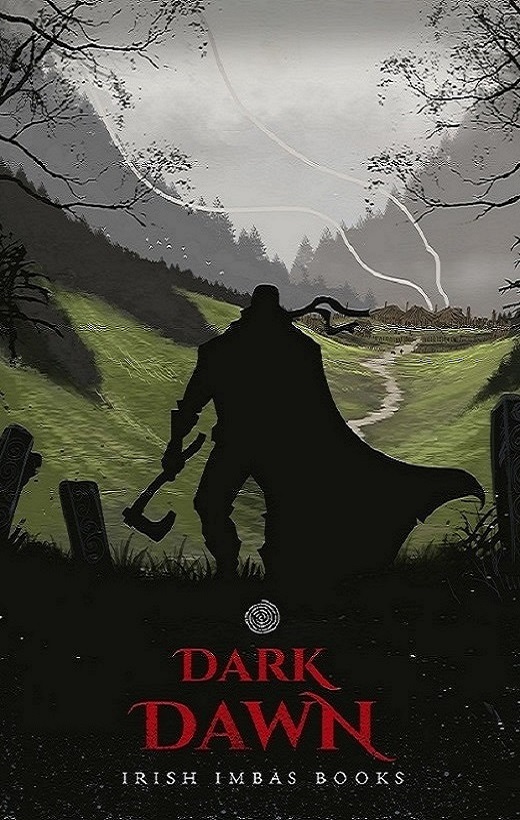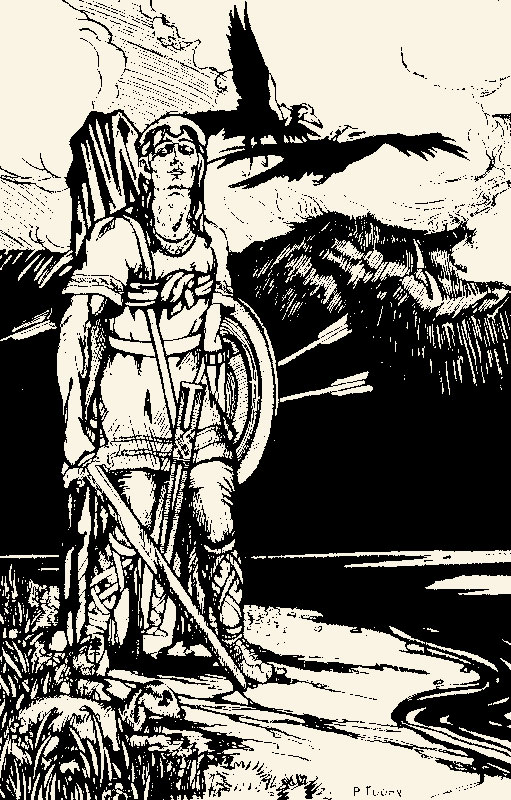
A dying warrior defends the isolated settlement of Ráth Bládhma, future home of Fionn mac Cumhaill.

A dying warrior defends the isolated settlement of Ráth Bládhma, future home of Fionn mac Cumhaill.

This week I’m recommencing work on Dark Dawn/ Camhaoir Fuilsmeartha, a new kind of Irish adventure which I’m hoping to release in Janurary 2021. At this stage, I can only say that it’ll be quite different to anything I’ve produced so far.
Unfortunately, this project dropped by the wayside as a result of the Covid-19 pandemic (the associated lockdowns and the mad workload that resulted directly as a result of that). Given the amount of time I’d invested in it, that was something of a disappointment but it’s nice to think I can now start the ‘salvage’ process.
My preference is for the Irish title (Camhaoir Fulilsmeartha) which means ‘Bloodspattered Dawn’ as opposed to ‘Dark Dawn’. You can find the Goodreads link here: Dark Dawn/ Camhaoir Fuilsmeartha

One thread that occasionally raises its head throughout Irish mythology is the motif associated with the burial process of some rí (a word often mistranslated as ‘king’ but more accurately translated as ‘chieftain’) or mythological celebrities, where the corpse is bound upright or interred in the standing position, usually in defiance of an enemy or rival population group.
The early and medieval Irish literature contains several references in this regard but the most famous is probably linked to that of Cú Chulainn who, in a final act of defiance, ties himself to a standing stone to die on his feet. Facing his enemies, he remains upright for three days after he dies as they’re too terrified to come close (clearly, nobody thought of throwing a stone!).
Another celebrity associated with upright burials was Laoghaire (son of the infamous Niall). Famous for his hostile interactions with Saint Pat, Laoighaire is recorded (by Tíreachán) as being buried on the ridges of Tara, placed upright and facing south in defiance of the Leinster tribes. This follows somewhat in his father’s footsteps, given that Neill’s body was also said to have been held aloft by his tuath as a good-luck token when heading off to battle.
Early Irish literature has a few other references to the bodies of chieftains and heroes being buried upright and although there is a possibility that might have reflected some kind of burial ritual linked to the cult of warriors, it’s very much a literary motif rather than a historical one. As a result, you really have to be careful with its interpretation.

Sometimes I wonder how we got to this place.

Had a timely ‘blast from the past’ today when I received a reminder of a book cover from October 2014 (for FIONN: Traitor of Dun Baoiscne). It was timely given that Amazon have somehow managed to revert to printing my paperbacks with the older covers instead of the more recent versions (which have been in place for some years).
Back when I first started writing and publishing, there were far fewer artists available to do illustrations and limited stock photos that you could purchase within a shoestring budget. For 1st/2nd century Ireland – the time/culture in which my books are set – finding ‘representative’ covers was particularly difficult. Despite many days searching, in the end I had no choice but to resort to fantasy-style photostock and using a graphic artist to try and ‘Gaelicise’ the result as far as possible.
I was never entirely comfortable with the resulting image. The fanboy, Red-Sonya fantasy style image I ended up with, really didn’t work that well for the culturally-realistic feel I was trying to reintroduce in our mythological narratives (not to mind the lack of realism around Irish weather!). As a result, this cover (deservedly) endured some serious piss-taking (predominantly from my partner, daughter, editor [female], proof-reader [female]).
Despite that, it proved remarkably popular until I could finally afford to replace it. Skimpy-clothed model aside, I think the standing stone, the colour and the background terrain worked really well.

Presenter Andy Linton interviews myself and fellow Irish writer and musician Pat Higgins at ‘Capital Irish’. You can find the interview below:
I start talking at about five minutes in and keep on talking (mostly about the Fenian Cycle, the influence it’s had on my own writing, a little bit about the proposed Liath, Celtic Warrior television series etc.) until someone wrestles the mircophone off me.
Pat Higgins finally gets a chance to talk a little about his book ‘Begotten Not Made‘ a character drama set in Galway based on true events in Pat’s family.

Fiachail mac Codhna
Fiacail mac Codhna is a swaggering and irrepressible warrior from the Fionn mac Cumhaill Series. Handsome, charming, and shrewdly strategic in battle, Fiacail’s potential for tribal greatness is undermined only by an over-sexed libido and a strong weakness for women, particularly where it relates to Bodhmhall ua Baoiscne – aunt of the famous Fionn mac Cumhaill.
Fiacail’s quite a lot of fun to write. He has no delusions of grandeur and he can be charmingly crass at times – particularly where it relates to sex – but his humour and genuine attraction to Bodhmhall means he’s a credible third player in the love triangle with Bodhmhall and Liath Luachra. His bawdy humour and blunt demeanour, meanwhile, offers some welcome relief from some of the more serious and intellectual characters in the series.
When not chasing women, Fiacail likes to walk around naked in the morning having conversations with Great Father Sun. Much of this involves trying to convince Father Sun not to cause the end of the world but also to give him a pony.
Over the course of the original Fenian Cycle narratives, Fiacail turns up on several occasions, usually as a kind of foster father/advisor to the young Fionn mac Cumhaill although, at one point, he’s also referred to as a reaver.
In modern Irish, ‘fiacail’ is actually the word for ‘tooth’, so it’s an odd name for a character and the ancient Fenian Cycle manuscripts offer little explanation of its derivation.

I came across an interesting folk legend in Skerries last time I was home, which tickled my fancy. Like much of our native topographical narratives, the story relates to Saint Patrick (many of the pre-Christian cultural sites including holy springs, wells, and others were renamed for him by the Christian Church as their influence grew in Ireland).
This story relates to a cluster of islands off the seaside village Skerries, in County Fingal. The local and most common version of the story tells how St. Patrick was expelled from the Wicklow region by the (cough) pagan natives. Disgruntled, by his lack of success, the Saint headed north and landed on a small island (“the outer island still called by his name” – Inis Pádraig or St. Patrick’s Island) off Skerries which he intended to use as a safe base from which to convert the ‘natives’. Accompanying him on this new mission, was a goat which he used for companionship and as a source of milk.
One day, while he was off on the mainland haranguing the locals, a separate bunch of them turned up on the island where they found Patrick’s goat. Feeling hungry, and having forgotten to pack a picnic lunch, they killed the goat and ate it before heading back to the mainland.
Patrick, returning to the island after a hard day at the pulpit, was upset (inconsolable) to find his goat missing. Full of fury, he took two giant strides (the first, taking him to Colt Island, the second to Red Island) to step back onto the mainland to confront the people living in modern-day Skerries.
Gathering the natives on the beach, he accused them outright of eating his goat and when they attempted to deny it, the guilty locals found themselves unable to speak and could only respond in bleats. When they were finally ready to confess their sins and drop to their knees before the Great Saint (and the Superior God, of course) their voices finally returned.
This story is pretty typical of the religious propaganda of the day but there are also several very familiar mythological constructs running through the story (and I haven’t included all of them). Overall, the current story is pretty typical of ‘Lazy Man Folklore’ or ‘Tourist Folklore’ (where the focus is more on the entertaining and fantastical elements of the story rather than the more interesting facts behind it). It’s a fun story but it’d still be nice if the Tourist Board could get off its butt and add a bit more of the actual history next time around.

Tá cumha i ndiaidh an bhaile ag titim isteach orm inniu.
It’s an interesting dilemma with respect to homesickness when you’re living on the wrong side of the planet. In the past, I could always live away with the knowledge that I could jump on a plane and be back in Cork within 2-3 days.
In the days of Covid however, with its quarantines, lack of aircraft and astronomical flight costs, such reassuraces no longer carry much weight. I expect to see a lot more immersion in Irish writing over the year to come.

Narratives and concepts from Irish mythology – or any other mythology for that matter – are often used by the advertising industry. One of the reasons for this is that mythology offers commonly recognised cultural narratives and culturla constructs which can be easily adapted to the advertising industry’s use of simplified visual concepts, stereotypes and targeted soundbites.
I recently came across some images for a Guiness campaign linked to the Guinness-sponsored All-Ireland Hurling Championship (developed in 2005 by Yoke Productions) which uses the mythological narrative of Cú Chulainn as the basis for a campaign entitled ‘Stuff of Legends’. That was actually a very clever idea. The well-known Cú Chulainn narrative already has an established link to the ancient sport of hurling but by linking it to the product (Guinness) through the use of the word ‘Stuff’ (this has an association to Guiness through ‘Aah, great stuff!’ etc.) and sponsorship of the Hurling Championship, a whole web of clever patriotic associations were made between Irish culture.
Fortunately, this being a home-grown Irish production, the narrative didn’t veer too far into the ‘fantasy’ trap (although it did of course utilise the more fantastical story elements of the Ulster Cycle stories). Looking at the imagry produced for the advertisments, you’d have to say the advertisers did an excellent job. The ‘look’ and the ‘theme’ are quintisentially Irish, the adds are visually attractive and, overall, it works very well.
They did however – from a mythologyical perspective – cock up one of the three campaign images. Can you tell which one it is? Image A, Image B or Image C?
The Answer:
The answer, of course, is Image B. Cú Chulainn has no association with the Giants Causeway in the image. This was actually a Fionn mac Cumhaill story.
Although, eh … I don’t think Fionn had a hurley!


THE IRISH TARDIS
Spotted in the Wicklow hills about three years ago.
Naturally, it didn’t work.
Bloody Eirecom! (%!!$#!)!